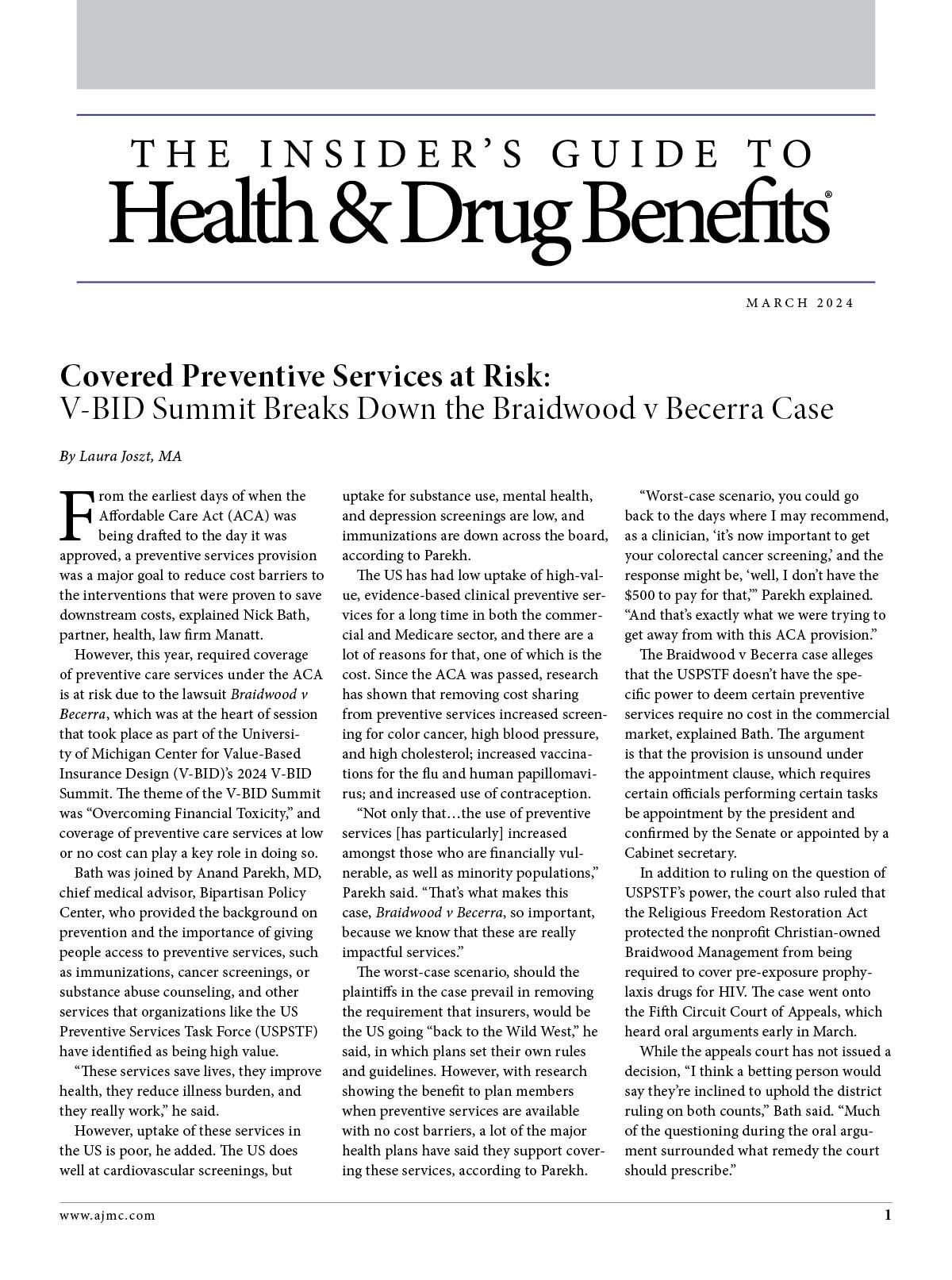- Center on Health Equity and Access
- Clinical
- Health Care Cost
- Health Care Delivery
- Insurance
- Policy
- Technology
- Value-Based Care
Fragmented Payer System, Vulnerable Supply Chain Among Threats to Accessing Essential Medicines
During a session of the 2024 V-BID Summit, panelists Stacie Dusetzina, PhD, and Inma Hernandez, PharmD, PhD, discussed how access to essential medications is curtailed not just by the longstanding complexities of insurance design but also by emerging threats such as supply chain weaknesses and cyberattacks.
The barriers standing between patients and the prescription medications they need extend far beyond the pharmacy counter, according to panelists who spoke at a 2024 V-BID Summit session Wednesday. The session, “Enhancing Access to Essential Medications,” fit into the summit’s theme of “Overcoming Financial Toxicity,” which is a particular focus for the University of Michigan Center for Value-Based Insurance Design (V-BID Center).
Stacie B. Dusetzina, PhD, Vanderbilt School of Medicine

Stacie Dusetzina, PhD, professor of Health Policy and Ingram Professor of Cancer Research at the Vanderbilt School of Medicine Department of Health Policy, and Inma Hernandez, PharmD, PhD, professor at the University of California, San Diego Skaggs School of Pharmacy and Pharmaceutical Sciences, approached the threats to medication access from different angles. Both Dusetzina and Hernandez are members of the editorial board of The American Journal of Managed Care®.
Dusetzina, whose research focuses on insurance design and the impacts of drug costs, began by dividing her thoughts on drug access into 2 categories: the common prescriptions like insulin, inhalers, and blood thinners that are used by millions of patients on a chronic basis, and the big-budget items such as cell and gene therapies or glucagon-like peptide-1 (GLP-1) receptor agonists that are causing financial pressure across the health system.
Access is mediated by insurance, Dusetzina explained, and because Medicaid is required to cover FDA-approved drugs with low cost sharing, her remarks focused on the challenge of commercial and Medicare insurance. Deductibles and coinsurance are key barriers to accessing chronic disease medications, and the unpredictability of these costs month to month can make it hard for patients to budget. Some recent bright spots include the $35 caps on insulin adopted by Medicare and some states, the Inflation Reduction Act (IRA) provision specifying no cost sharing for vaccines under Part B, and the IRA’s establishment of month-to-month payment smoothing and a $2000 annual out-of-pocket maximum. Employers are also starting to be more creative with covering some high-value therapies on a predeductible basis, Dusetzina noted.
On the other hand, new high-cost drugs such as cell and gene therapies and CRISPR-based technologies are putting immense pressure on the system to afford their price tags of millions of dollars per patient treated. Less costly individually but applying to a huge population of eligible recipients, GLP-1 drugs are also threatening to hike costs that will get passed along to the employer, patient, and taxpayer. The Center for Medicare and Medicaid Innovation is trying to create outcomes-based agreements for these costly therapies, Dusetzina said, but there is a long road ahead.
Moderator Cliff Goodman, PhD, senior vice president at the Lewin Group, noted new therapies for Alzheimer disease as another emerging therapeutic category with a massive eligible population that could threaten to break the system. The principles of VBID will need to be applied to each drug and its clinical benefits to establish which are worth paying for when considering their potential to reduce downstream spending, Dusetzina explained, before proposing a different way of thinking about how to balance budgets to enable access to transformative therapies.
“We’d have to really be creative about how exactly do we pay for it and where do we invest in more of a single-payer type of strategy or negotiation, thinking a little bit like how we handled COVID-19 vaccines and treatments, as when we have such innovative treatments that are real breakthroughs for people, should we think about those not as this fragmented set of payers but in a more coordinated way?”
Inmaculada (Inma) Hernandez, PharmD, PhD, University of California, San Diego

Next, Hernandez, whose work focuses on pharmaceutical access, reminded listeners that barriers to access are not always related to insurance coverage. For instance, generic drugs are reimbursed by pharmacy benefit managers at markups exceeding 1000% in some cases, and because these reimbursement rates are the basis for patient cost sharing, patients are paying an inflated amount for generic drugs through their insurance that often exceeds what they would pay via cash. This paradox has led to the popularity of direct-to-consumer options like the Mark Cuban Cost Plus Drug Company, leaving the current system of pharmacy benefits ripe for reform.
A second threat to access is the nation’s vulnerable drug supply chain, which is enduring a record high number of drug shortages. The problem is exacerbated for generics because they compete only on price, Hernandez said, and this pricing pressure means manufacturers can’t raise prices when production costs increase. Congressional hearings have discussed value-based reimbursement as a solution, in which providers would be paid more for selecting generics coming from more resilient supply chains.
Resiliency is also being put to the test in cybersecurity, as evidenced by the crippling effects of the Change Healthcare outage on claims processing and reimbursement.1 Pharmacies are dispensing drugs with the plan to submit claims once the system is restored, so the attack hasn’t affected patient care, but we may not be so lucky next time. Other countries have seen drug wholesalers attacked, Hernandez noted, which could be catastrophic in the US where just 3 wholesalers dominate the market.
Finally, a serious threat to medication access is the creation of pharmacy deserts as independent pharmacies are forced to shut their doors. With direct-to-consumer options like Cost Plus Drug meeting more of the demand for generics and mail-order pharmacies providing more specialty drugs, Hernandez wondered how small, local pharmacies will be able to stay open to deliver essential services like giving vaccines.
“This is just a sample of some new and some prevalent issues that threaten patient access to important medications beyond prices and some issues that, in my opinion, are also prime for policy reform,” Hernandez concluded.
Goodman then asked the panelists for their input on why prescription drugs often cost more in the US than other countries. The fragmentation of the US health system into individual state Medicaid programs, federal Medicare, and commercial payers means that no one player has as much leverage in negotiations, Dusetzina said, and there is not as much political will to take the risk of curtailing treatment choices if their manufacturers will not negotiate their prices. The IRA’s drug price negotiation effort may be able to illustrate the effect of negotiation in the US—if it can survive a gauntlet of legal challenges and the fate of the presidential election in November.
Another challenge is that serious considerations around equity need to be included in efforts to ensure access to cutting-edge drugs, with Hernandez noting the potential for disparities to be exacerbated by lack of insurance coverage. She worried that the stigma of obesity has driven the decision not to cover the GLP-1s despite their impressive therapeutic profile.
“We cannot pretend to be serious about health equity and not have these conversations around coverage of these drugs that are indicated for diseases that have a disproportionate burden for underrepresented minorities and underserved populations,” Hernandez said.
She added that the FDA’s approval of an expanded indication for semaglutide (Wegovy) to prevent cardiovascular events2 should help to encourage wider coverage, so if she had carte blanche to pull one policy lever that would expand access, she would instead choose pharmacy benefit manager reform to improve transparency.
In keeping with the mission of the summit’s host, Dusetzina’s wish-list item would be the incorporation of more VBID principles so that coverage and cost sharing would be based on a treatment’s value.
“That means really focusing a lot on low-value treatments and making those less accessible, less likely to be covered. Stop spending so much money there, and spend more money on the things that really benefit patients and get the outcomes that we want.”
References
1. AJMC Staff. What we’re reading: crackdown on counterfeit Ozempic; ALS drug fails in clinical trial; cyberattack profit losses. AJMC. March 11, 2024. Accessed March 13, 2024. https://www.ajmc.com/view/what-we-re-reading-crackdown-on-counterfeit-ozempic-als-drug-fails-in-clinical-trial-cyberattack-profit-losses
2. Mattina C. FDA approves semaglutide to prevent heart events in patients with CVD and excess weight. AJMC. March 8, 2024. Accessed March 13, 2024. https://www.ajmc.com/view/fda-approves-semaglutide-to-prevent-heart-events-in-patients-with-cvd-and-excess-weight

CMS' 340B Repayment Proposal May Harm Vulnerable Hospitals, Reward Those With Higher Revenues
April 26th 2024The 340B hospitals not receiving an offsetting lump-sum payment from CMS following 2018-2022 cuts later ruled unlawful are disproportionately rural, publicly owned, and nonacademic, according to a new study.
Read More
Examining Low-Value Cancer Care Trends Amidst the COVID-19 Pandemic
April 25th 2024On this episode of Managed Care Cast, we're talking with the authors of a study published in the April 2024 issue of The American Journal of Managed Care® about their findings on the rates of low-value cancer care services throughout the COVID-19 pandemic.
Listen
Navigating Health Policy in an Election Year: Insights From Dr Dennis Scanlon
April 2nd 2024On this episode of Managed Care Cast, we're talking with Dennis Scanlon, PhD, the editor in chief of The American Journal of Accountable Care®, about prior authorization, price transparency, the impact of health policy on the upcoming election, and more.
Listen
The Federal Trade Commission's (FTC's) vote to ban most employers from issuing and enforcing noncompete clauses could have varying impacts on the health care workforce; federal regulators vastly under-enforced antitrust laws in the hospital sector during the last 2 decades, resulting in increased health costs; the FDA recently found genetic evidence of the H5N1 bird flu virus in pasteurized commercially purchased milk.
Read More
